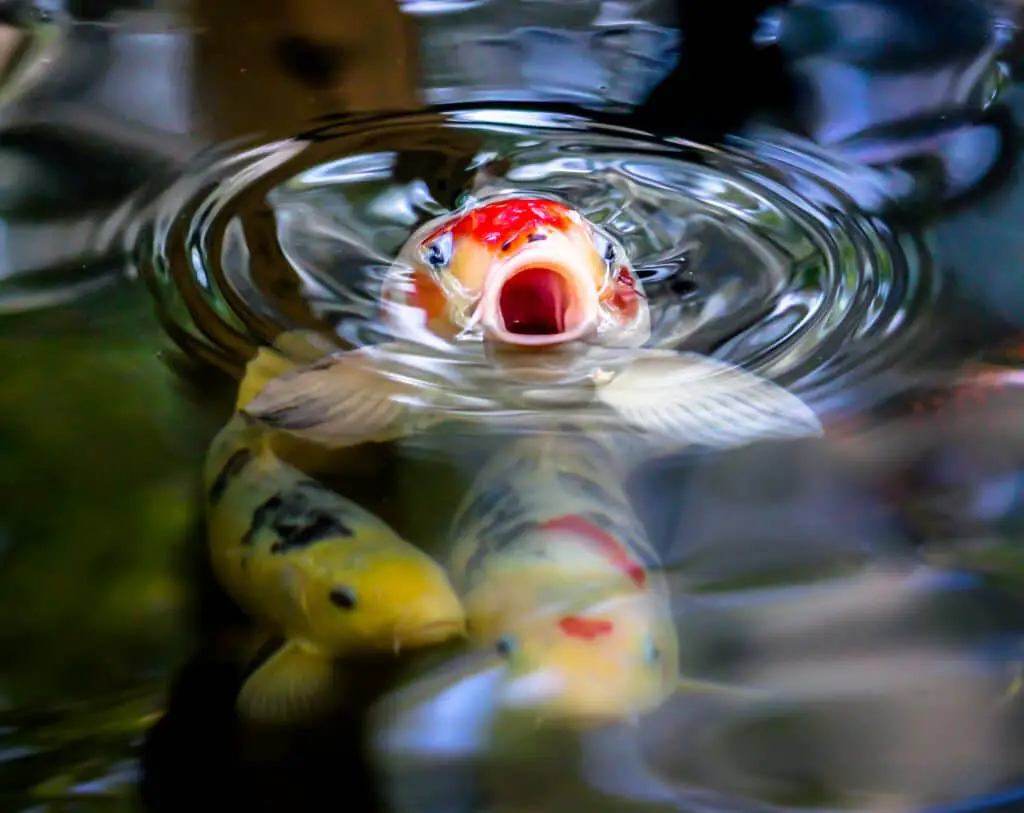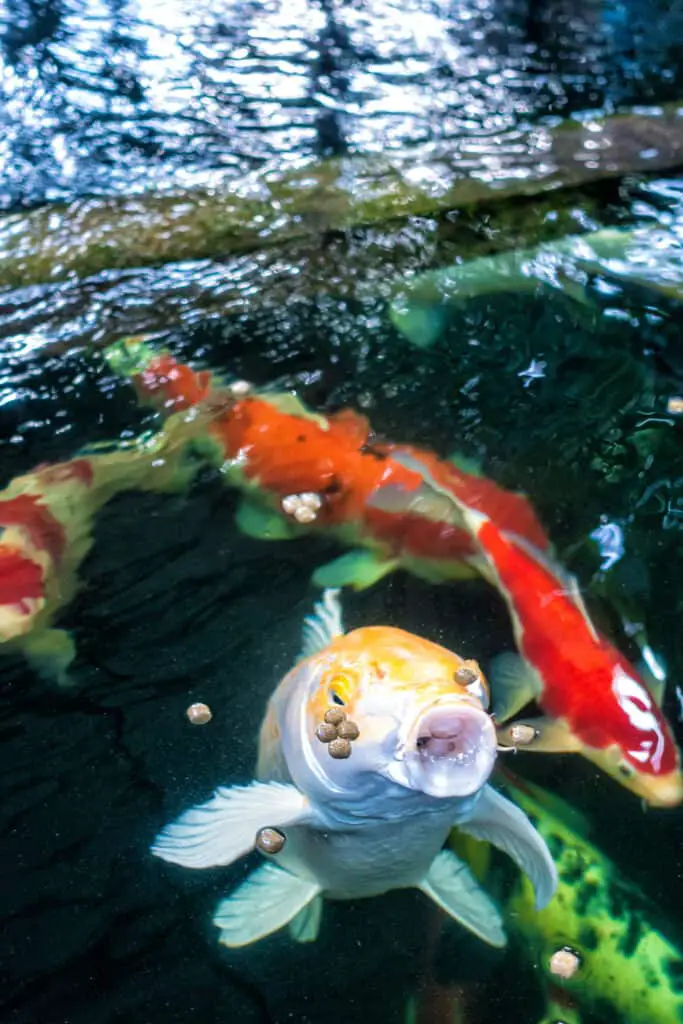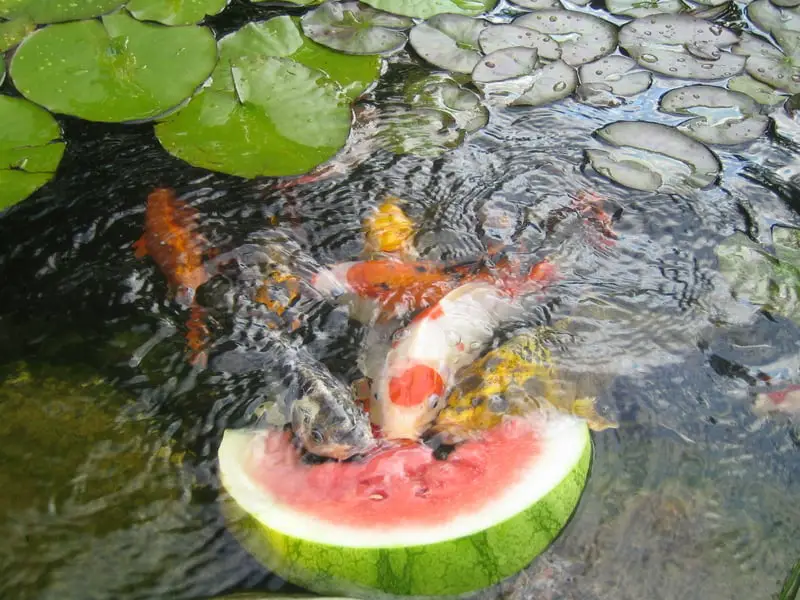
Answering how often to feed koi fish is not quite as simple as it seems. A couple of factors affect how much and how often you should feed your koi fish. The size of the fish, the season, and the water temperature affect when you should feed your koi with a particular type of feed.
Generally, koi fish need to be fed 2 to 4 times a day. At each feeding session, give koi as much food as they can eat in 5 minutes. Please adjust the quantity of food and the frequency of feeding based on the size of the fish and how active they are. Koi need more food in summer and almost none during winter.
Why are koi fishes’ eating patterns so erratic? And why does one need to feed different types of feed at other times of the year? Here, we discuss how koi fish feed and metabolize their food and how to establish an effective feeding program for your koi pond all year round.
How Often Should You Feed Koi Fish?
How often you feed your koi fish depends mainly on the water temperature and how active the fish are. It is best to feed koi when they are at their most active.
At temperatures between 66°F and 70°F, koi should be fed once or twice daily. At slightly warmer temperatures between 71°F and 75°F, they should be fed 2 to 4 times a day. At temperatures between 76°F and 80°F, they can be fed 2 or 3 times a day.
In hot weather, when the water temperature is 81°F to 85°F, only feed koi every second day. At temperatures above 86°F, koi will not eat much, so reduce feeding to a minimum.
In winter, when water temperatures are below 40°F, you should not feed koi fish because they cannot feed when it is this cold. Their metabolisms slow right down, and they are not very active.
In spring, as the water temperatures start to increase to between 41°F and 50°F, feed koi fish once or twice a week. As the water warms from 50°F to 55°F, increase feeding to 2 to 3 times a week.
In mid to late spring & early summer, when the water is 56°F to 60°F, feed koi 3 to 4 times a week. When the water gets to between 61°F and 65°F, feed them 4 to 5 times a week.
How Is Temperature Linked With How Koi Feed?
Monitoring the water temperature of your koi pond is key to knowing how often to feed your fish. But what does the water temperature have to do with how many times a day you should feed your fish?
First, it is important to understand how koi fishes’ metabolisms work. As cold-blooded or poikilothermic creatures, koi fish cannot control their body temperature—Koi’s body temperature changes with their external environment (the pond water).
As the temperature of the water changes throughout the seasons, koi fishes’ body temperature and metabolic rate change. The warmer the water, the higher their metabolic rate, the more active they are. The cooler the water, the slower their metabolic rate, and the less engaged they are.
When koi fish are more active, their bodies burn more energy, and therefore, they need to eat more frequently. Koi fishes’ metabolisms function optimally when the water is at 70°F. When koi fish are less active at cooler temperatures, their bodies use less energy, so they do not need to eat as frequently.
This is how water temperature is linked to the frequency of feeding. Having a thermometer for your koi pond is absolutely essential!
Factors That Affect How Often You Should Feed Koi Fish
Many factors influence when you should be feeding your koi fish, how often, and what type of food you should be giving them. Please pay attention to all these variables to ensure that your koi fish get the optimal nutrition they need.
- Koi fish size – fry vs adults
- Season – summer/fall/winter/spring
- Water parameters – temperature, oxygen content
- Weather conditions
Generally, you should aim to feed your koi fish 1-4% of their body weight every day. Younger koi fish called fry use a lot of energy while growing. Therefore, they require more food relative to their body weight than adult koi.
Water temperatures change with the seasons. Depending on where you live, season changes can be drastic, requiring you to adapt your feeding program throughout the year. Your koi fishes’ feeding program will stay more constant in temperate regions without big seasonal shifts.
When water temperatures are colder than 40°F, koi fish enter a state of hibernation. During winter, their metabolic rate slows, and they stop feeding. Therefore, you have to feed koi more during the warmer months and less during colder months.
The oxygen levels in the pond water also affect how active koi fish are. When there is lots of oxygen, fish will eat more because they are more active.
The oxygen levels in the water depend on the levels of ammonia in the water and atmospheric conditions. For example, directly after a storm, the water’s oxygen levels are lowest, so it is not a good time to feed.
The more fish feed, the more waste they produce, and the higher ammonia levels in the water lead to lower oxygen levels. This is why overfeeding koi fish can decrease the water quality and cause fish to feed less.
The Best Time To Feed Koi Fish

We have established that koi fishes’ feeding habits are closely linked to water temperature, so what is the optimal time of day to feed koi?
Early in the morning, when the sun has just risen, the pond water is still quite cold, and the koi fish are sluggish. This is not a great time to feed. The same goes for the evening after the sun has dropped below the horizon.
Between 10 am-2 pm is the best time of day to feed koi fish when the water temperature is around 68°F to 70°F – the most optimal temperature for koi to feed.
During the hottest weeks in summer, you need to try to feed your koi during the cooler parts of the day because they do not feed when the water temperature is above 85°F.
How Much To Feed Koi Fish
Generally, the rule for working out how much to feed koi is “1 to 4% of their bodyweight”. In theory, this guideline seems really helpful, but in practice, how are you going to weigh your fish and calculate exactly how much to feed as a portion of their body mass?
There is a far simpler way to work out how much you need to feed your koi fish, but it requires trial and error.
Feed koi fish 2 to 4 times a day, and in each feeding session, give the koi as many pellets as they will eat in 5 minutes. Throw in a small handful, wait for them to finish it, and then throw in another.
Notice if there is any food left after 5 minutes have passed. If so, feed a little less next time. If none is left, try feeding a little more.
It is important to watch the koi’s behavior closely. After a while, you will learn how they look when they are still a bit hungry or when their appetites are satiated.
Take note of the quantities you are feeding until you have enough experience to judge the correct amount.
Remove uneaten pellets from the pond before they sink to the bottom!
Can You Overfeed Koi Fish?
Overfeeding koi fish is a very common mistake that pond owners make. It lowers the water quality, and it isn’t good for the fishes’ health, so it is very important to avoid overfeeding.
Koi fish will only eat a certain amount of food, and the leftovers sink to the bottom of the pond. As they decompose, they release ammonia into the water.
The higher the ammonia levels in the water, the lower the oxygen levels; in high levels, ammonia is toxic, making the pond water murky.
Overfeeding koi fish also stresses their digestive systems and their organs. It causes them to release more waste (poop) into the water. This contributes to lowering the water quality further.
If your fish are looking a bit bloated, and you suspect you have overfed them, skip feeding for a day.
How Long Can Koi Fish Go Without Food?
Underfeeding koi is a very rare problem amongst pond owners. Because koi fish are naturally opportunistic feeders, they can survive for extended periods without food, especially in established ponds where they can forage algae and insects.
When koi fishes’ metabolic rates slow down over winter, they can survive almost an entire season without being fed. During summer, healthy koi fish can survive a whole week without being fed.
Should I Consider An Automatic Feeder For Koi?
Feeding koi fish by hand is interactive and fun, but unfortunately, not everyone has the time to hand feed their koi fish multiple times a day.
An automatic feeder is useful for ensuring that your fish are fed the right quantity on a consistent schedule. A feeder is also great for when you want to go away on vacation!
There is a wide variety of automatic feeders on the market, but all of them can be programmed to feed a set quantity on a specified schedule at a given frequency. Some models are battery-operated with small solar panels. These are fantastic if you do not have a power outlet near your pond.
Only invest in a feeder designed to allow moisture to escape from the feed chamber. The high-protein pellets will quickly spoil if moisture accumulates in the storage compartment.
What To Feed Koi Fish
In the wild, koi fish are omnivorous, and they eat a diverse range of foods. They feed on algae, insects, plant matter, and whatever bits of animal matter float past them.
When you keep koi in a pond, you are responsible for providing them with a complete and varied diet that meets all their nutritional and energetic needs.
If koi fish do not get all the nutrients they need, their colors appear dull, their immune systems weaken, their growth slows, and their overall health deteriorates.
There are three main types of koi feed: grower pellets, color pellets, and winter pellets. Grower pellets are for fueling rapid growth. Color pellets enhance the fishes’ color, and winter pellets are a more easily digestible, wheat germ-based feed.
To ensure your koi fish eat a balanced diet, feed them with high-quality koi pellets. The protein content of the pellets is key. Young koi growing fast need pellets with at least 50% protein, and adult koi fish need pellets with 30 to 40% protein.
During warmer months of the year, feed koi high-protein grower pellets to maximize their growth during the season. During cooler parts of the year, in the fall and spring, koi should be fed with a wheat germ-based feed that is lower in protein.
When water temperatures are between 40°F and 60°F, feed koi only wheat germ-based pellets. Feed a combination of protein-based and wheat germ-based pellets when the water temperature is between 61°F and 70°F.
Only feed protein-based color pellets when the water temperature is between 71°F and 85°F. When the water temperature is above 85°F, cut back on feeding and only feed a little wheat germ-based pellet.
Which Foods Can Koi Eat As A Treat?

There are many different foods that you can feed koi as a treat to add more diversity to their diet. Here are just a few:
- Watermelon slices
- Cheerios
- Grapefruit slices
- Squash
- Wheat germ
- Unpeeled prawns or shrimp
- Romaine lettuce
- Grown break
- Orange halves
- Spinach
- Krill
- Earthworms
Foods That Are Not Safe For Koi
Avoid giving koi fish any of the following:
- Meat
- Corn
- Pasta
- White bread
- Peas
- Candy
- Potatoes
- Dairy
Conclusion
Feeding koi the right type of food, in the correct quantity, at the right times of day will ensure that they stay healthy and the pond water quality stays high.
Koi fish generally need to be fed 2 to 4 times per day, but the feeding frequency should be adjusted depending on the water temperature. At very high (>85°F) and very low (<40°F) temperatures, koi fish are unlikely to feed. They are most hungry and active at around 70°F.

